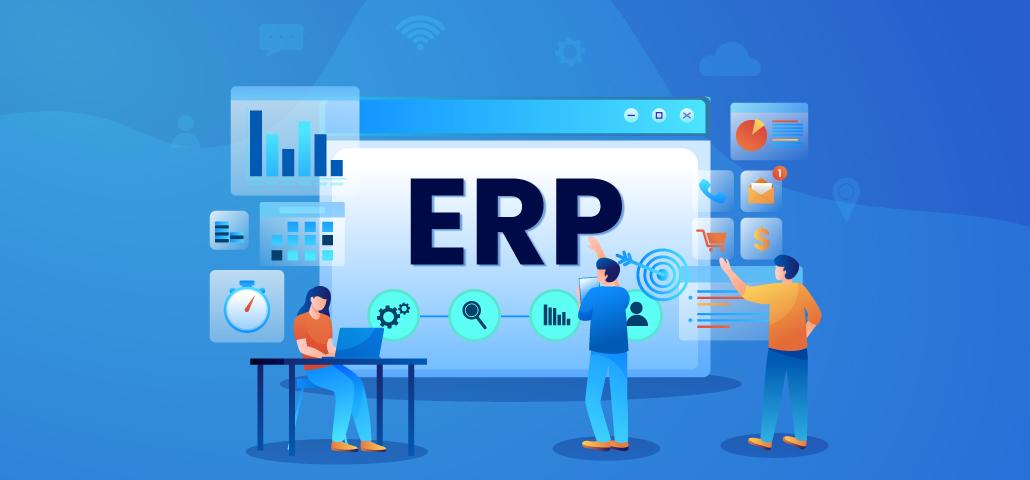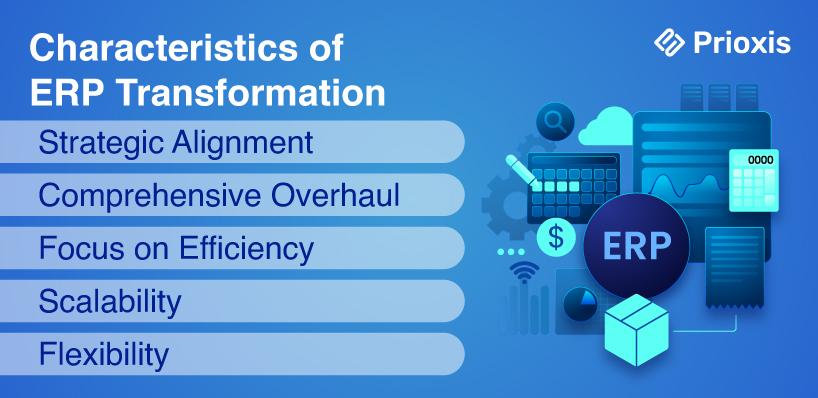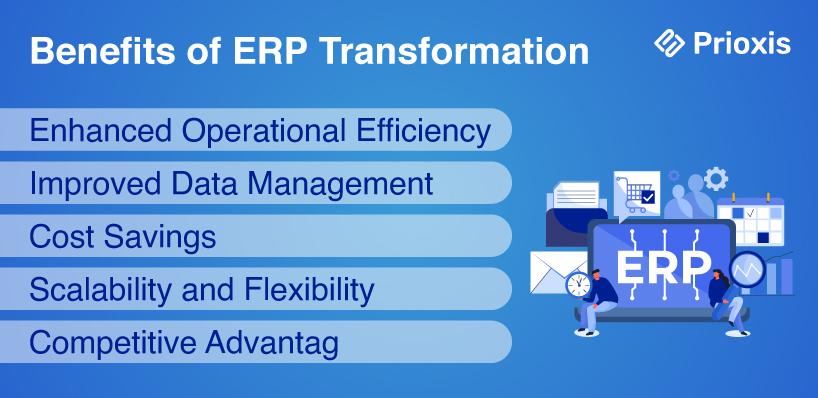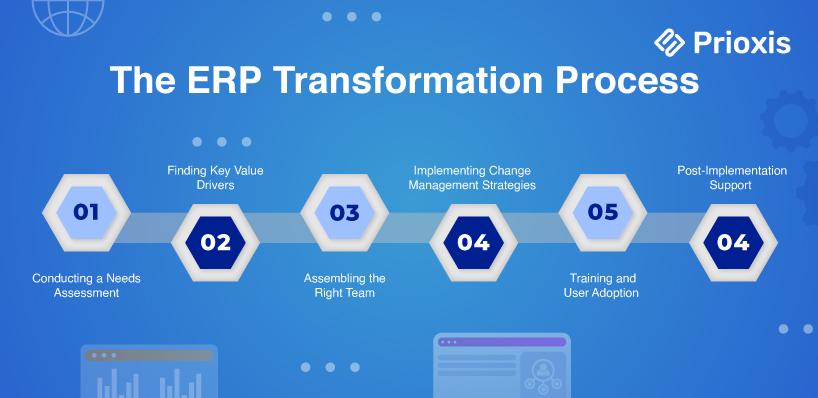ERP Transformation: Benefits, Process and Best Practices
 Admin
Admin Digital Transformation
Digital Transformation Aug 21, 2024
Aug 21, 2024

Table of Content
ERP Solutions serve as the backbone of organizational processes. But today, the need for modernization has become more pressing than ever. An outdated ERP system can hinder growth and innovation and put the company at a competitive disadvantage.
This is why 76% of businesses have moved their on-premise ERP to the cloud. And if you, too, want to reap the benefits of ERP transformation, this guide is for you.
In this blog, you will find reasons for ERP transformation. The blog also covers its benefits, the process, potential challenges, and best practices for success.
ERP Transformation Definition
ERP transformation is a complete revamp of an organization's ERP system beyond updating software. It involves reassessing and reshaping business processes, adding new technologies, and aligning the ERP system with the company's strategic goals.
The primary goal is to create a more agile, efficient, and scalable system. A system that can support the organization’s current needs while providing flexibility to adapt to future challenges.
This transformation could involve
- Moving from a legacy on-premises ERP system to a modern cloud-based platform.
- Combining many disparate ERP systems into a single unified platform.
- Integrating advanced technologies like artificial intelligence, machine learning, and predictive analytics.
ERP transformation aims to improve operational efficiency, data management, and business outcomes.
Key Characteristics of ERP Transformation
1. Strategic Alignment The new ERP system must support the organization's long-term goals and align with its strategic vision.
2. Comprehensive Overhaul This isn’t a software upgrade; it involves completely rethinking the organization's operations.
3. Focus on Efficiency Streamlining and automating processes to reduce manual labor and errors.
4. Scalability The transformed system must grow with the business, accommodating increased complexity and scale.
5. Flexibility The ability to adapt to changing business needs, market conditions, and technological advancements.
When Does Your Organization Need ERP Transformation?
Understanding when to undertake ERP transformation is crucial. It ensures your organization stays competitive and capable of meeting future challenges. Here are some key indicators that your organization might be ready for such a significant change:
1. Outdated ERP System
If your ERP system uses outdated technology that doesn't meet your business needs, it might be time for a transformation. Legacy systems often need help to meet modern business requirements.
For instance, real-time data processing, mobile accessibility, and integration with other advanced technologies. An outdated ERP system creates bottlenecks, and manual steps complicate processes. Re-evaluate the system to address compliance and security concerns.
2. Inefficiencies & Redundancies
Too many manual steps and repeated tasks can complicate business processes, which often involve inefficient workflows. An ERP transformation can help streamline operations and cut waste. An outdated ERP system can lead to decreased productivity and increased operational costs.
3. Scalability Issues
As your business grows, your ERP system must scale accordingly. If your current system can't handle more transactions or support new business models, it's time to transform. The inability to scale can hinder your organization’s growth and lead to missed opportunities.
4. Business Strategy Alteration
Significant changes in your business strategy, like entering new markets or expanding product lines, often need re-evaluating your ERP system. This is also necessary during mergers or acquisitions. This is to ensure it aligns with your new direction.
An ERP transformation can offer the needed flexibility to support strategic changes and help achieve your business goals.
5. Compliance & Security Concerns
If your ERP system doesn't meet regulatory requirements or has security risks, a transformation may be necessary to ensure compliance and protect your organization from risks.
Regulatory environments are becoming complex. An outdated ERP system may need to be equipped to handle the necessary reporting, data privacy, and security standards.
Difference Between ERP Transformation and ERP Update
| Aspect | ERP Transformation | ERP Update |
|---|---|---|
| Scope | Comprehensive overhaul of the ERP system, involving rethinking processes and integrating new technologies | Incremental changes, such as software patches or version upgrades |
| Impact | Significant, aiming to improve efficiency, scalability, and strategic alignment | Limited, focused on maintaining and slightly enhancing current functionality |
| Goals | Proactive; aligns ERP with long-term business goals | Reactive; addresses immediate system needs |
ERP Update
An ERP update involves making minor changes or enhancements to the existing system. This could include applying patches, upgrading to a newer software version, or adding new features. Updates are often routine and focus on keeping the system functional and up-to-date. They don't alter the system's fundamental structure or processes.
The updates are necessary to keep the system’s performance and security. They do not address deeper systemic issues or align the ERP system with long-term strategic goals.
ERP Transformation
In contrast, ERP transformation is a comprehensive overhaul redefining the organization's operations. It’s not about updating the software but involves rethinking processes, integrating new technologies, and sometimes changing the entire ERP platform.
Transformation aims to improve efficiency, scalability, and alignment with business goals. ERP transformation is a long-term strategic initiative designed to future-proof your organization and drive business value.
Explore More: What is an ERP System, and How does it work?
Benefits of ERP Transformation
Undertaking an ERP transformation can provide many benefits, positioning your organization for long-term success. Here are some of the key advantages:
1. Enhanced Operational Efficiency
ERP transformation allows you to streamline and automate business processes. It reduces the need for manual intervention and minimizes errors. Your organization can run more efficiently by improving the flow of information and automating routine tasks. This leads to faster decision-making and increased productivity. Automated workflows also reduce the likelihood of human error, ensuring that processes are completed correctly and consistently.
2. Improved Data Management
A modern ERP system combines data across all departments, providing a single source of truth for the entire organization. This centralized data management enhances transparency, enables data-driven decision-making, and improves reporting accuracy.
With real-time access to right data, decision-makers can find trends and challenges and make informed decisions that drive the business forward.
3. Cost Savings
While the first investment in ERP transformation can be significant, the long-term cost savings are huge. Organizations can see a considerable return on investment (ROI) over time. ERP transformation cuts inefficiencies, reduces manual labor, and improves resource use. Additionally, modern ERP systems often lessen the need for expensive hardware and maintenance particularly if the organization moves to a cloud-based solution.
4. Scalability and Flexibility
A transformed ERP system is designed to grow your business. Whether expanding into new markets, launching new products, or scaling operations, a modern ERP system can adapt to your needs. It provides the flexibility needed to support growth. This scalability ensures that the ERP system can handle increased transaction volumes. It also supports complex processes and integrates with other systems as the business evolves.
5. Competitive Advantage
By using the latest technologies and improving your business processes, ERP transformation can give your organization a competitive edge. It enables you to respond quickly to market changes, meet customer demand, and innovate faster than competitors still reliant on outdated systems.
A modern ERP system can also offer better insights into customer behavior, supply chain efficiency, and market trends. It lets you make strategic decisions that keep you ahead of the competition.
The ERP Transformation Process
1. Conducting a Needs Assessment
Start by assessing your current ERP system to understand its limitations. This includes mapping your existing processes, finding inefficiencies, and pinpointing your organization's needs.
The aim is to develop a clear vision of what you need from the new ERP system. Conducting a thorough needs assessment will help ensure that the transformation aligns with your strategic goals and tackles your organization's most pressing issues.
2. Finding Key Value Drivers
Once you understand your needs, the next step is finding the key value drivers for your ERP transformation. These may include improved data visibility, enhanced compliance and risk management, cost reduction, inventory optimization, and scalability.
These value drivers will guide your decision-making when choosing the right ERP solution. Finding these drivers early ensures that the transformation delivers measurable benefits that align with your organization’s strategic goals.
3. Assembling the Right Team
A successful ERP transformation requires a cross-functional team with representation from all key departments. This team should include an executive sponsor, project manager, department leads, IT professionals, business analysts, and change management specialists.
Each member is crucial in ensuring the project stays on track and meets its goals. The project team is liable for driving the transformation and making critical decisions. They ensure that all aspects of the organization are aligned with the new system.
4. Implementing Change Management Strategies
Change management is a critical aspect of ERP transformation. It involves preparing your organization for the changes ahead, managing resistance, and ensuring all stakeholders are on board.
Effective communication, training, and support are essential to smooth the transition and enable user adoption. Without a robust change management strategy, even the most well-designed ERP system can fail to achieve its goals due to a lack of user buy-in and resistance to change.
5. Training and User Adoption
Comprehensive training is key to ensuring that users are comfortable with and can use the new system. Tailor the training to different user roles. Also provide ongoing support to address any challenges post-implementation.
Training should be role-specific, ensuring users understand how to perform their tasks within the new system. Additionally, ongoing support is essential to address issues and ensure users continue using the system.
6. Post-Implementation Support
Continuous support is crucial once the ERP system is live to address any issues and improve system performance. This includes monitoring system usage, resolving technical problems, and gathering user feedback to make necessary adjustments.
Post-implementation support ensures that the system meets the organization’s needs and can be fine-tuned as the business evolves. Regular system updates, performance monitoring, and user feedback are all essential components of a successful post-implementation strategy.
Challenges of ERP Transformation
While ERP transformation offers significant benefits, it also comes with its challenges. Understanding and preparing for these challenges is crucial to ensuring a successful transformation.
1. Resistance to Change
Challenge:
Employees accustomed to old working methods may resist new systems and processes. Overcoming this resistance requires clear communication, involvement in the process, and comprehensive training.
Solution:
Changing management strategies must address employees' concerns. Management should provide the support and resources they need to adapt to the new system.
2. Technical Difficulties
Challenge:
ERP transformation often involves complex integrations and data migration. This can be technically challenging.
Solution:
Ensuring that your IT team can handle these challenges is essential. Data migration, in particular, can be a significant challenge, requiring careful planning and execution to ensure that all data is transferred accurately and securely. You can also outsource the data migration process to an experienced team to ensure success.
3. Budget Overruns
Challenge:
ERP transformation can be costly, and budgets can quickly spiral out of control without careful management.
Solution:
Planning carefully, setting realistic budgets, and tracking expenses throughout the project are necessary. Contingency planning is also essential to address unexpected costs during the transformation process.
4. Timeline Management
Challenge:
Staying on schedule can be difficult, especially if unexpected challenges arise.
Solution:
A detailed project plan, regular progress reviews, and flexibility to adapt are crucial to keeping the project on track. Effective timeline management requires close coordination between all project team members and quick resolution of any issues that could cause delays.
Best Practices for ERP Transformation
To ensure the success of your ERP transformation, consider the following best practices:
1. Stakeholders Involvement
Engage key stakeholders from the beginning to ensure their needs are met and to secure their buy-in. This helps align the transformation with the organization’s strategic goals and reduces resistance. Early stakeholder involvement ensures that the transformation addresses the organization's most critical needs and that all stakeholders are committed to the project’s success.
2. Focus on Change Management
Develop a robust change management plan with clear communication, training, and support. This will help manage resistance and ensure a smooth transition. A comprehensive change management plan addresses the transformation's technical and human aspects, ensuring that all employees are prepared for and supportive of the changes.
3. Focus on Training & User Support
Invest in training to ensure all users are confident using the new system. Provide ongoing support to address issues and help users fully use the system’s capabilities. Training should be continuous, with opportunities for users to refresh their skills and learn new features as the system evolves.
4. Track & Adjust
Continuously track the progress of your ERP transformation and be prepared to adjust as needed. Flexibility is critical to navigating challenges and ensuring the project stays on track. Regular progress reviews, feedback loops, and performance metrics are essential for watching the transformation's success and making necessary adjustments.
5. Partner with Experienced Consultants
Leverage the ability of external consultants who can provide guidance, best practices, and support throughout the transformation process. Their experience can help you avoid common pitfalls and ensure a successful implementation. Prioxis brings a wealth of knowledge and ability to the table, helping to ensure that your ERP transformation is completed on time, within budget, and to the highest possible standards.
Conclusion
Transforming your ERP system is crucial for modernizing operations, boosting efficiency, and staying competitive. Although the process can be complex, the rewards are significant.
If you're dealing with outdated technology or scalability issues, a strategic ERP transformation can help you meet your goals.
At Prioxis, we specialize in guiding businesses through this transformation to ensure success and drive growth. Our 5+ years of experience have helped companies worldwide achieve their digital goals.
Get in touch




